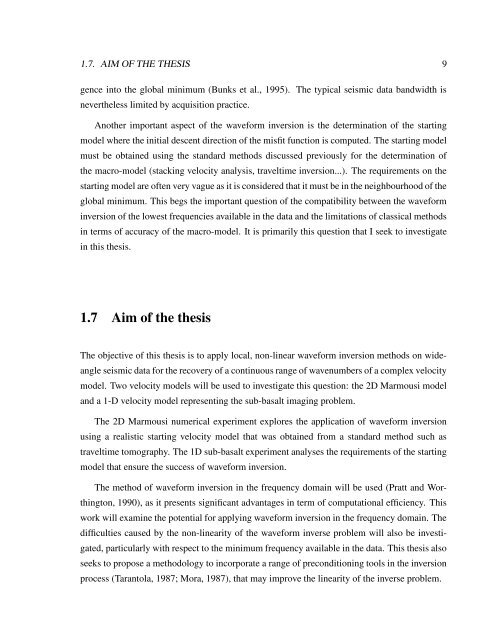Sirgue, Laurent, 2003. Inversion de la forme d'onde dans le ...
Sirgue, Laurent, 2003. Inversion de la forme d'onde dans le ...
Sirgue, Laurent, 2003. Inversion de la forme d'onde dans le ...
You also want an ePaper? Increase the reach of your titles
YUMPU automatically turns print PDFs into web optimized ePapers that Google loves.
1.7. AIM OF THE THESIS 9<br />
gence into the global minimum (Bunks et al., 1995). The typical seismic data bandwidth is<br />
neverthe<strong>le</strong>ss limited by acquisition practice.<br />
Another important aspect of the waveform inversion is the <strong>de</strong>termination of the starting<br />
mo<strong>de</strong>l where the initial <strong>de</strong>scent direction of the misfit function is computed. The starting mo<strong>de</strong>l<br />
must be obtained using the standard methods discussed previously for the <strong>de</strong>termination of<br />
the macro-mo<strong>de</strong>l (stacking velocity analysis, traveltime inversion...). The requirements on the<br />
starting mo<strong>de</strong>l are often very vague as it is consi<strong>de</strong>red that it must be in the neighbourhood of the<br />
global minimum. This begs the important question of the compatibility between the waveform<br />
inversion of the lowest frequencies avai<strong>la</strong>b<strong>le</strong> in the data and the limitations of c<strong>la</strong>ssical methods<br />
in terms of accuracy of the macro-mo<strong>de</strong>l. It is primarily this question that I seek to investigate<br />
in this thesis.<br />
1.7 Aim of the thesis<br />
The objective of this thesis is to apply local, non-linear waveform inversion methods on wi<strong>de</strong>ang<strong>le</strong><br />
seismic data for the recovery of a continuous range of wavenumbers of a comp<strong>le</strong>x velocity<br />
mo<strong>de</strong>l. Two velocity mo<strong>de</strong>ls will be used to investigate this question: the 2D Marmousi mo<strong>de</strong>l<br />
and a 1-D velocity mo<strong>de</strong>l representing the sub-basalt imaging prob<strong>le</strong>m.<br />
The 2D Marmousi numerical experiment explores the application of waveform inversion<br />
using a realistic starting velocity mo<strong>de</strong>l that was obtained from a standard method such as<br />
traveltime tomography. The 1D sub-basalt experiment analyses the requirements of the starting<br />
mo<strong>de</strong>l that ensure the success of waveform inversion.<br />
The method of waveform inversion in the frequency domain will be used (Pratt and Worthington,<br />
1990), as it presents significant advantages in term of computational efficiency. This<br />
work will examine the potential for applying waveform inversion in the frequency domain. The<br />
difficulties caused by the non-linearity of the waveform inverse prob<strong>le</strong>m will also be investigated,<br />
particu<strong>la</strong>rly with respect to the minimum frequency avai<strong>la</strong>b<strong>le</strong> in the data. This thesis also<br />
seeks to propose a methodology to incorporate a range of preconditioning tools in the inversion<br />
process (Taranto<strong>la</strong>, 1987; Mora, 1987), that may improve the linearity of the inverse prob<strong>le</strong>m.

















